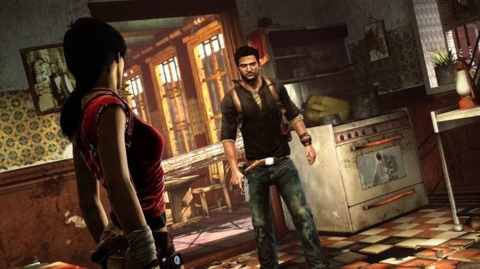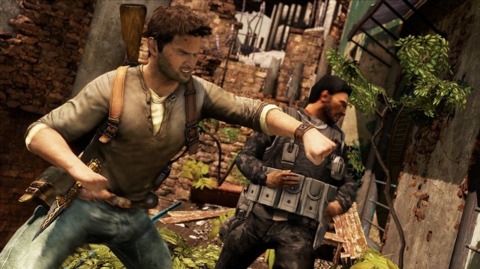Naughty Dog dissects Uncharted 2
GDC 2010: Co-lead game designer Richard Lemarchand maps out the many pitfalls his studio had to overcame to release 2009's award-winning action adventure.
Who Was There: Having laid out Naughty Dog's "seat of your pants" design philosophy at this year's DICE Summit, co-lead game designer Richard Lemarchand turned out at the 2010 Game Developers Conference to provide a postmortem on Uncharted 2: Among Thieves, which picked up a record five Game Developers Choice Awards tonight.

What He Talked About: Lemarchand began his postmortem by providing a rough overview of how Naughty Dog starts each of its projects. He said that Uncharted 2's design process began by creating a short list of project goals that the team would refer back to.
Of these goals, he said the team wanted to create a fully playable version of a big summer blockbuster action adventure that kept the player in moment-to-moment control throughout the play experience. The game itself, he said, would rely on adventure romance and pulp fiction tropes, with a story that didn't take itself too seriously and explored the theme of trust and betrayal. Naughty Dog also wanted a story that was character-driven, deciding to include a larger cast of characters than the acclaimed 2007 original. These extra characters would serve as emotional satellites, revealing more about the main character, Nathan Drake.
Naughty Dog spent the first six months of Uncharted 2's 22-month development cycle on preproduction. Here, the team had no conventional deadlines, he said, with the focus placed on free-form ideas, concept art, and lots of prototyping. Out of this, they came up with ideas that they felt were too good not to include, such as the train sequence or the cliff-side monastery scene.
Of that train sequence, Lemarchand said that it was one of the first they conceived and last to be completed in the game. In fact, the sequence drove much of the technology in the game, including what he called the "dynamic object traversal system," which gave Drake the ability to more freely move and act in the game's environments.
These independent ideas were eventually cobbled together by way of an elaborate flash-card system, as certain events were arranged and rearranged along a bulletin board to achieve an ideal order. These cards ultimately led to Uncharted 2's macro design, which is like a traditional design document only far more concrete. Ideas such as swinging on free ropes, hand-over-hand free climbing, and the ability to pull out Drake's gun at any point all came out of this process.

The preproduction phase is also when they hit upon incorporating lots of set-piece sequences. Lemarchand cautioned that though these high-intensity scenes were very rewarding for players, they were incredibly time-consuming to create. In the end, they hired highly technical scripting designers to make sure everything got done on time.
Lemarchand said that one drawback for so heavily developing the game in preproduction is that there was no real time for reflection. As a result, fairly late in the development process, the team realized that there weren't enough strong beats in the game to warrant the long gameplay. But, because they had already committed so much to the final ending, they had to make it all fit.
Once into full production, Lemarchand likened the development process to Gromit from Wallace and Gromit laying train tracks just ahead of a speeding locomotive in the Oscar-winning short The Wrong Trousers. Levels were first designed using block mesh, which let the team sketch out an experimental flow, and they simply began building out the level with art, play testing, and iterating. He said that a problem with rushing ahead like this is that they miss opportunities to create interesting scenes or elements. It can also lead to game design that could be misleading or confusing to the player, a problem Lemarchand said was prevalent in Uncharted 2.
The game designer then noted that with about nine months before launch, the team realized that Uncharted 2 suffered from serious frame-rate issues. Fixing these issues and bringing the game up to 30 frames per second became of paramount importance, and the team took it to the wire to iron it out.
One scene in particular that was exceptionally problematic for the studio was the aforementioned train sequence. "An evil monster" to create, the train sequence had 50 separate cars that all moved. This is opposed to how developers have handled it in the past, where the train itself is static and the background simply zips by.

He said that to solve the issues with the train, they had to do a lot of "weird stuff," like teleporting the train to various positions depending on, for example, where players died. This, of course, led to a good many bugs, such as when enemies dropped a weapon, it would fly off into space, or a thrown grenade would be flung back at the player's face. All in all, shoring up these bugs helped tighten up the game.
Moving on to Uncharted 2's initially controversial multiplayer component, Lemarchand said that much of Drake's movement and abilities were simply ported over to the online arenas, and it worked well. Naughty Dog also hired a dedicated multiplayer designer, noting also that the co-op missions "may have been the point where we overextended ourselves." At the end of the day, though, Lemarchand said that the multiplayer actually helped the single-player game, because the snappiness of online play fed back into making the story mode more crisp.
Lemarchand then addressed the game's 2009 E3 demo, the first public exhibition of the game. He said that basically the only thing that had any kind of polish in that demo was what was onscreen, and turning the camera even a fraction in the wrong direction would have exposed a lot of embarrassing behind-the-curtain, in-development content. He also said that it was this showing that made the team realize just how much they had bitten off and still needed to finish.
Lemarchand said that "one last disaster" in the game's development process is that the team did not adequately allot enough time for postproduction needs. Therefore, particle artists and the like were left scrambling up until the end to reset certain effects that had been disrupted by certain late changes. In the future, he said, Naughty Dog plans to build a proper postproduction phase into the schedule.
Quote: "Not only did the game run at 30 frames per second, but also 60 miles per hour!"--Richard Lemarchand, on ironing out Uncharted 2's frame rate issues on the all-too-problematic train level.
Takeaway: Uncharted 2 proved to be an arduous undertaking that resulted in its fair share of hiccups in development. However, with its emphasis on set-piece design and character-driven gameplay, not to mention loads and loads of hard work, Naughty Dog managed to ship one of the most highly decorated games of 2009.
Why Are Video Game Adaptations Good Now? | Spot On Fallout 4 Next Gen Update Comparison Fallout 4 Steam Deck Verified Gameplay ALIEN: Rogue Incursion - Announcement Teaser Trailer Stellar Blade - 13 Things I Wish I Knew S.T.A.L.K.E.R. 2: Heart of Chornobyl — Official "Not a Paradise" Trailer Manor Lords - Official Medieval City Builder/RTS Launch Trailer Honkai: Star Rail - "Then Wake to Weep" | Version 2.2 Trailer Devil May Cry: Peak Of Combat | Dante: Blazing Tempest Gameplay Trailer SAND LAND — Official Launch Trailer Sea of Thieves Season 12: Official Content Update Video Stellar Blade - Hard Mode No Damage Gigas Boss Gameplay
Please enter your date of birth to view this video
By clicking 'enter', you agree to GameSpot's
Terms of Use and Privacy Policy
Got a news tip or want to contact us directly? Email news@gamespot.com
Join the conversation